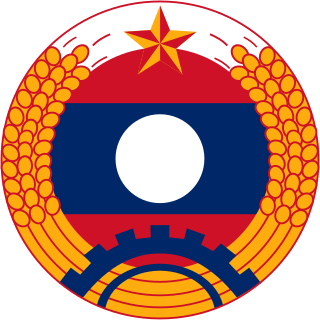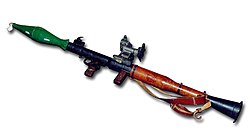Lao People's Armed Forces
Combined military forces of Laos From Wikipedia, the free encyclopedia
The Lao People's Armed Forces (LPAF; Lao: ກອງທັບປະຊາຊົນລາວ) or the Lao People's Army (LPA) is the armed forces of the Lao People's Democratic Republic and the institution of the Lao People's Revolutionary Party, who are charged with protecting the country.
| Lao People's Armed Forces | |
|---|---|
 Emblem of Lao People's Armed Forces | |
 Flag of the Lao People's Armed Forces | |
| Founded | 20 January 1949 |
| Service branches | Lao People's Army (includes Riverine Force) Lao People's Air Force Self-Defense Militia Forces[1] |
| Headquarters | Vientiane |
| Leadership | |
| Governing body | Defence and Public Security Commission |
| DPSC Chairman, President and General Secretary | Thongloun Sisoulith |
| Minister of Defence | General Chansamone Chanyalath |
| Chief of the General Staff | Lieutenant General Khamlieng Outhakaysone |
| Personnel | |
| Military age | 18- 45 years of age for compulsory military service |
| Conscription | minimum 18 months |
| Available for military service | 1,500,625 males, age 15–49 (2005 est.), 1,521,116 females, age 15–49 (2005 est.) |
| Fit for military service | 954,816 males, age 15–49 (2005 est.), 1,006,082 females, age 15–49 (2005 est.) |
| Reaching military age annually | (2005 est.) |
| Active personnel | 100,000 |
| Reserve personnel | 30,000 |
| Expenditure | |
| Budget | $18.5 million (2019) |
| Percent of GDP | 0.5% (2006) |
| Industry | |
| Foreign suppliers | China Vietnam Russia United States Ukraine Indonesia Historical: |
| Related articles | |
| History | First Indochinese War Vietnam War |
| Ranks | Military ranks of Laos |
Active forces
The army of 29,100 is equipped with 30 main battle tanks. The army marine section, equipped with 16 patrol craft, has 600 personnel. The air force, with 3,500 personnel, is equipped with anti-aircraft missiles and 24 combat aircraft (no longer in service).
Militia self-defence forces number approximately 100,000 organised for local defence. The small arms utilised mostly by the Laotian Army are the Soviet AKM assault rifle, PKM machine gun, Makarov PM pistol, and the RPD light machine gun.
Organization
The LPAF is divided into four military regions, with its headquarters in Vientiane
- Military Region One (Luang Prabang)
- Military Region Two (Phonsavan)
- Military Region Three (Xépôn)
- Military Region Four (Pakxan)
The LPRP statute states that its political leadership over the military emanates from the LPRP Central Committee's Defence and Public Security Commission (DPSC) and is the highest decision-making institution regarding military and security affairs.[2]
History
Summarize
Perspective
Until 1975, the Royal Lao Armed Forces were the armed forces of the Kingdom of Laos.
Serving one of the world's least developed countries, the Lao People's Armed Forces (LPAF) is small, poorly funded, and ineffectively resourced. Its mission focus is border and internal security, primarily in internal suppression of Laotian dissident and opposition groups.[1]
This includes the suppression of the 1999 Lao Students Movement of Democracy demonstrations in Vientiane, and in countering ethnic Hmong insurgent groups and other groups of Laotian and Hmong people opposing the one-party Marxist–Leninist LPRP government and the support it receives from the Socialist Republic of Vietnam.[1]
Together with the Lao People's Revolutionary Party and the government, the Lao People's Army (LPA) is the third pillar of state machinery, and as such is expected to suppress political and civil unrest and similar national emergencies faced by the government in Vientiane. The LPA also has reportedly upgraded skills to respond to avian influenza outbreaks. At present, there is no major perceived external threat to the state and the LPA maintains very strong ties with the neighbouring Vietnamese military (2008).[1]
According to some journalists, non-governmental organisations (NGOs), humanitarian and human rights organisations, the Lao People's Army has repeatedly engaged in egregious human rights violations and the practice of corruption in Laos.[3][4] The LPAF and its military intelligence play a major role in the arrest, imprisonment and torture of foreign prisoners in Vientiane's notorious Phonthong Prison and the communist Lao gulag system where Australians Kerry and Kay Danes were imprisoned and where civic activist Sombath Somphone may be imprisoned following his arrest in December 2012.[5]
In 2013, attacks by the Lao People's Army against the Hmong people intensified, with soldiers killing four unarmed Hmong school teachers in addition to engaging in other human rights abuses according to the Lao Human Rights Council, the Centre for Public Policy Analysis and others.[6]
Equipment
Summarize
Perspective
Tanks, armored vehicles and trucks
Artillery
| Photo | Model | Type | Origin | Quantity | Notes |
|---|---|---|---|---|---|
| Dongfeng CS/SS4 | Self propelled mortar system | 14[citation needed] | |||
| SR-5 | Multiple rocket launcher | 12 | |||
 |
BM-21 Grad | 122mm multiple rocket launcher | 32 | ||
 |
BM-14 | Multiple rocket launcher | 20 | ||
 |
2S3 Akatsiya | 152mm self-propelled howitzer | Unknown | ||
| 122-HL-70 | 122mm self-propelled howitzer | 18 | |||
 |
PCL-09 | 122mm self-propelled howitzer | 12 | ||
 | M-30 122 mm howitzer | Towed howitzers and guns | 15[15] | ||
 | 122 mm howitzer 2A18 (D-30)[citation needed] | 20[15] | |||
 | 130 mm towed field gun M1954 (M-46)[15] | ||||
 | M114 155 mm howitzer[15] | 12[15] | |||
 | M101 howitzer | 105mm (towed): M-101[15] | 20[15] | ||
 | M116 howitzer[15] | 75mm (towed): M-116 pack | 10 | ||
Air defense
| Photo | Model | Type | Origin | Quantity | Notes |
|---|---|---|---|---|---|
 |
S-125 Neva/Pechora | Short-range SAM system | Unknown | ||
 |
9K35 Strela-10 | Vehicle-mounted SAM system | Unknown | ||
| Yitian anti air system | Surface-to-air missile | Unknown | |||
 |
ZSU-23-4 Shilka | Self-propelled anti-aircraft gun | Unknown | ||
| Strela-2 | Surface-to-air missile | Unknown | Received 100 launchers from Soviet Union in the 80s[18] | ||
 | 37 mm automatic air defence gun M1939 (61-K) | Air defence gun | Unknown | ||
 | 57 mm AZP S-60 | Automatic anti-aircraft gun | Unknown | ||
 | ZPU | Auto anti-aircraft gun | Unknown | ||
 | ZU-23-2 | Anti-aircraft gun | Unknown | ||
Weapons
Mortars
Accidents
On 17 May 2014, Defence Minister and Deputy Prime Minister Douangchay Phichit was killed in a plane crash, along with other top ranking officials.[25] The officials were to participate in a ceremony to mark the liberation of the Plain of Jars from the former Royal Lao government forces.[26] Their Russian-built Antonov AN 74-300 with 20 people on board crashed in Xiangkhouang Province.[27]
See also
References
External links
Wikiwand - on
Seamless Wikipedia browsing. On steroids.






























